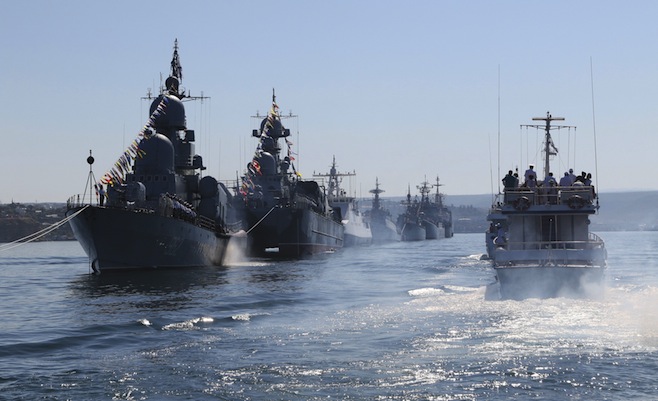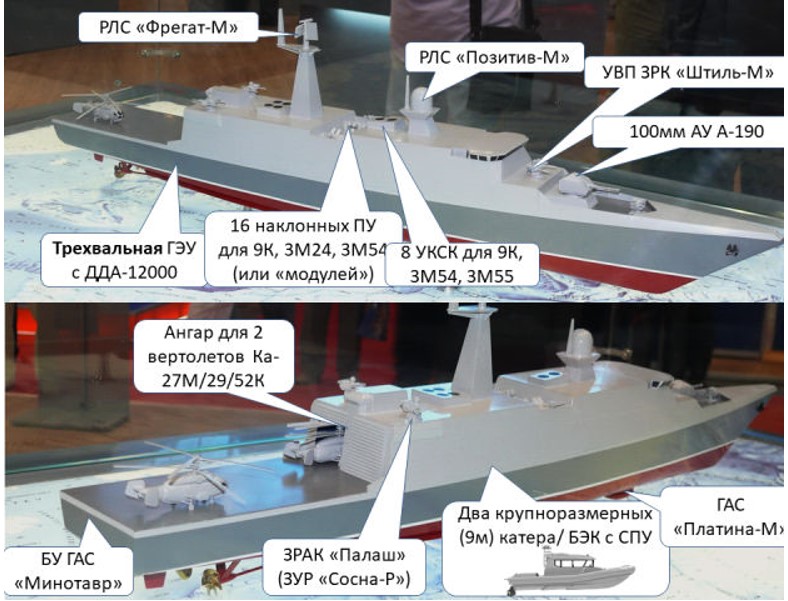On October 19, 2018 SouthFront released an analysis titled “Russia’s New Maritime Doctrine And Issues With The Surface Fleet“. It adressed the current issues with the Russian surface fleet and how they impact the country’s maritime doctrine. It seems that analysis and opinions of SouthFront experts are now being confirmed by Russian specialists. The issues with the surface fleet are now among the key topics discussed by Russian military experts.

Russian warships are seen during a rehearsal for the Navy Day parade in Sevastopol, Crimea, July 24, 2015. REUTERS/Pavel Rebrov
Written by Captain 3rd Rank Maksim Klimov; Originally appeared on Vpk.name, translated by J.Hawk exclusively for SouthFront
1. Critical problems
– Coastal zone ships are worn out, obsolete, have lost their combat value;
– Oceanic-zone ships are obsolete, worn-out, expensive to operate, and are very few in numbers, thus a naval “collapse” is inevitable in the early 2020’s.
– New projects and modernization:
- Project 22350 frigates. Four have been ordered, a bigger design is needed (Project 22350M) but since an appropriate powerplant is lacking, the 22350 order should be enlarged to at least 6 ships—three for Northern Fleet, three for Pacific Fleet.
- Project 20386 corvette—a flawed concept, very weak armament, but worst of all several fundamental technical problems have not been resolved, starting with the assessment of the deformation of the phased-array radar mount which is larger than the width of the beam itself, thus making it impossible to say whether the beam can be stabilized!
- Project 11711 amphibious assault ship—in spite of all its problems, it’s the most effective project for the oceanic zone (and such ships are simply indispensable for the functioning of the Navy), therefore it’s utterly puzzling why only 2 ships have been ordered (the first for the Northern Fleet), the minimum should be 2 ships (modernized, with stronger armament!) for Black Sea Fleet and Pacific Fleet, in order to maintain a permanent presence of one vessel in the Indian Ocean.
- Project 22160 patrol ship—a scandal wrought by the St. Petersburg Design Bureau and several officials. The ships are too slow, and lack seagoing ability means they can’t use helicopters or boats while underway, but the worst problem is that it’s a flawed concept. New threats and situation require far stronger ships.
- Project 12700 minehunter—an obsolete concept, it’s effective until it hits the first modern mine that will destroy it or its sole submersible UUV, plus it has powerplant construction problems.
- Project 22800 small missile ship—the most successful contemporary ship but…the Navy did not actually needed it (because modernized Project 1234, carrying not Uran but Kalibr missiles would have been far better, given the critical need for coastal ASW ships), and it also has issues with powerplant.
- Project 1155 large ASW ships—lagging and limited modernization, due to the servicing of the wiring being postponed and high operating costs (original plans included Kalibr missiles, new Tor missiles, powerplant overhaul, new radars, Minotavr sonar…).
- Project 11442(M) heavy cruiser—extremely costly, with an unviable modernization concept (“new Yamato”), clearly modernizing other ships is too costly and unviable (Yamato showed in 1945 what such ships are worth against air attack).
A good option would have been a normal modernization of Pr. 20380 (Kalibr in slanted launchers, radar “tower” from 22800, etc.), but Almaz stubbornly defended Pr. 20386.
The coastal zone is currently “naked”, both when it comes to ASW and minehunting, and the oceanic zone is awaiting a collapse.
2. Solution
It’s obvious that the Navy needs large classes of effective ships for both the coastal and oceanic zone.
Out of available assets, here’s what can be done:
- Increase Pr. 22350 by 2 ships (3 for Northern and Pacific fleets each)
- Increase Pr. 11771 by 2 ships (Black Sea and Pacific)
- Do not start new Pr. 22160 ships, and use the existing ones and those under construction to ensure security for North Stream.
- Given the powerplant situation, cancel contracts for Pacific Pr. 22800 and complete laid down ships in the West using old diesels and those small quantities of diesels which can be provided by Zvezda—there are no other options.
- Modernize Pr. 1234 with Kalibr missiles from slanted launchers
- Modernize Pr. 12700 in the course of construction.
But, most importantly, new projects are needed:
- Multirole corvette
- Oceanic frigate
- New small minehunter
When ship construction is delayed, yards accuse contractors, but there are “components” which can be relied on to ensure rapid ships construction, to prevent the ship collapse in the early ‘20s. It’s clear that given the financial situation, the cost of new ships should be limited.
The hardest problem is the coastal ASW. Only Kolomna and Minotavr are reliable. A “small Gepard” (with Karakurt layout) could be quickly put together under the state order system. A realistic construction term is 3 years, as shown by Karakurt. Ships should be built in pairs, given the specifics of their employment in groups.
The same goes for the frigate. Diesel powerplant (Kolomna), 3 screws (3 DRA 12000 diesels). It’s important to incorporate the powerplant planned for Pr. 20386, to avoid discarding already existing R&D. Construction time of 4.5 years seems realistic.
“Reliable Components”
The closest conceptual equivalent—the huge (over 50 hulls) series PRC Project 056 corvettes.
Pr. 12700 minehunter has three flaws:
- Obsolete concept
- Insufficient explosion resilience
- Inability to carry out multiple missions (even on Pr. 266M level).
What is more, there are problems with diesels, Zvezda can deliver one set a year. The ships are needed, but require modernization.
This requires immediate construction of several minehunters on the basis of Pr. 10750E (with suitable import substitution and improved performance), organized same as the Karakurt—state order from the yard.
What is more, one needs a new small minehunter design (500t), ensuring a new level of performance. But it doesn’t make sense to issue orders for new ships until we obtain experience with the latest systems which would gain from the modernized design.
The new ships would have to have strictly limited costs:
- Minehunters: 2.5 billion rubles
- Corvettes: 5 bilion rubles
- Frigates: 15-20 billion rubles.
3. Organizational matters
There is no alternative to used diesels to overcome Pr. 22800 problems, in spite of all official claims to the contrary. One option is to use diesels from small ASW ships (as they are replaced with corvettes), which would provide enough engines for the missile ships that have been built or are under construction, even when one considers Zvezda’s limited capacity.
Other systems should be reused as well, for example, artillery from small ASW and missile ships, which is in good condition so it can be reused on new ships, as other navies do. Given the situation and “legal restraints”, this solution could be adopted only by the Supreme Commander. It would also make sense to quickly prepare relevant reports and documents on these issues.
Author: Captain 3rd Rank Maksim Klimov
***
Russia’s New Maritime Doctrine And Issues With The Surface Fleet:










What is the point of this article?
none
There is point if somebody finally receives a lesson…
Russia should make strict control over their big mouthed officers.
Years ago…One big mouthed Russian high ranking officer has publicly declared that
T-90 was outdated and basically crap as tank (That was before Armata came out )
Indian army was totally shocked by that comment due to the fact that they were huge buyers of T-90 (“Brishma” as they call it) licence produced in India for needs of their army.
Today T-90SM (with some upgrades) is one of the best tanks money can buy and quite reasonable bang for a buck.
I don’t know what happened to that high ranking officer but he was WRONG just as much as this guy is wrong to write the article like that.
They are useful idiots of Western propaganda and they should be stopped to do the damage to the Russian army.
How can China’s naval power be greater then Russia’s with those shitty diesel engines they produce!?
UPDATE 07-12-18 re the atempted false flag / assassination attempt using an explosive underwater drone reported yesterday.
It appears that the brand new ship ‘Orekhovo-Zuevo’ and / or a ‘special’ Officer and his team on board were the target of the underwater drone mine!
Original report 06-12-18:
Reports coming in that yesterday a WW2 sea-mine was destroyed near a beach near Anapa (Black Sea not far from Kerch Strait). This was not a WW2 mine at all but a modern explosive packed remote control drone mine (like a big torpedo – details to follow). The WW2 mine story was a cover story so that this serious event can be investigated without the World watching.
Apparently, either an assassination attempt against a Senior Russian Military Officer onboard the ship, or an attempt to seriously damage the boat itself, was the objective (not clear yet as intel still coming in).
A team of special divers from Novorossiysk foiled the plot.
Details:
An undersea drone was detected directly below the planned route of an unnamed boat not far from the resort town of Anapa, just a few miles from the ship and a special military facility (in Novorossiysk).
Underwater drone appeared to be of western design and was carrying a conventional explosive device clearly of Ukrainian origin (unknown why it was ‘clearly’ Ukrainian).
It was detected during a security operation following a tip off. It was disabled, and an attempt at recovery made, but then abandoned due to very high risk of explosion (potential anti-tamper device noted).
Decision made to move drone away from boat route and lanes and then to detonate it as close to the coast as safe, so that forensic evidence could be recovered.
It is believed even at this early stage that the attack was a FALSE FLAG provocation to be blamed on Ukraine, forcing a Russian military responce (following a now well established pattern of provocations).
All forensic evidence now recovered and a cover up is now in operation.
As blast was seen and heard by 100’s of people the official cover story is that a WW2 sea-mine had been washed into the harbour and was safely disposed of by bomb-disposal teams from the nearby military facility.
No further details of device or the operation to find it and recover/disable it at this stage, but this is yet another provocation foiled.
Unknown who is responsible for provocation at this stage, but as Ukraine is already ruled out it leaves only the 2 usual suspects.
Link to official story and video:
https://sputniknews.com/russia/201812061070430971-ww2-mine-detonation/
Link to details of a very similar but not as powerful drone:
https://www.militaryaerospace.com/articles/2018/05/unmanned-underwater-vehicle-uuv-weapons-payloads.html
Link to video of ship believed to be the target:
https://youtu.be/Piyae6EhOxk
NOTE:
Non of this is yet confirmed, it is snatched intel leaked via a Ukrainian blog whos aim is to prevent war between Ukraine and Russia by leaking as much material as possible. The blog is correct approx 90% of the time.
There is a secret hot war currently going on intented to cause Russia to strike Ukraine. A powerful hand (Deep State?) is manipulating real people and playing with them like chess pieces.
Time is short now. More provocations expected, but likely to move back to Syria for next one!
My comment about the sea drone / mine was left as part of this article appeared to ‘drop’ a few references I rightly or wrongly interpreted as a coded shout out for info.
NOTE – this attack has now been CONFIRMED.
It was timed to take place on or as near as possible to, the anniversary of PEARL HARBOUR and was to be co-ordinated with a second attack (also foiled – but no further details yet)!
Russian officials are currently sticking to the story that the massive explosion seen near the route of the the ship was due to the controlled demolition of a WW2 era mine.
Leak suggests that Russia are currently putting together a major, Haig style ‘Incitement to War’ Legal case, and are currently not acknowloging this or the other multiple provocations earlier this week, or the most recent one today in Syria.
Details of this major international legal case expected to emerge early next year!
Jonas blog is now down so no further updates until he is restored.
The article doesn’t address budget issues. How much would the described improvements cost? What are the current allocations for this portion of the Russian military, and how would the author suggest a different allocation to implement the suggested modernization?
It sounds like he’s calling for the bulk of the Russian navy to be replaced with a new fleet. I’m guessing that that would be cost prohibitive with the current low government debt to gdp ratio, pay as you go, economic model being used by the Russian government. And that given the collapse of the Soviet economy that is still fresh in many people’s minds. That there’s an aversion to a return to that type of military procurement and spending for fear of weakening the Russian economy with excessive debt service in a manner that occurred in the past.
I live my life using a similar economic and security model. And have a blend of state of the art and legacy security equipment in various levels of modernization that is all paid for, as are the rest of my assets. That combined provide more advanced security capabilities than 99% of the rest of American society.
9 mm pistol, .32 acp pistol, .40 S&W 200 grain hard cast lead penetration rounds, 9 mm +p flat nose penetration rounds, .30-06 black tip armor piercing rounds, Bluetooth headset, .32 acp +p hard cast lead penetration rounds, .223 green tip armor piercing rounds, .223 tracer rounds.
https://uploads.disquscdn.com/images/c6ac9fa8606000b10f8a68f69b02ede89bdfab8db119cc9d58d51ce1fea8f8ed.jpg
I wasn’t able to run the natural spaceport op this week that I was planning to due to work delays that ate up the time that I had budgeted for the op. And the good weather this week in the theaters of operations is going to change to bad weather with wind, rain, fog, ice and snow depending on elevation levels for the next couple of weeks. I’m set up for all weather ops. But they’re slower, more complicated, difficult, and dangerous in bad weather. Particularly if there is non conventional/ET/ED contact. Involving security counter measures, camera and or sound recording work, etc..
Sounding like the aircraft carrier aspiration is pointless…
Perhaps a container ship based arsenal ship could perform a similar role but without having the expensive to operate, manned, strike air wing component?
Russia builds the best missiles and planes on the planet, but lousy ships.
Accept your limitations and buy Chinese ships off the shelf, it will be cheaper.
Or go for quality, and buy German like in the past.
Nonsense!
Why are Russian ships “lousy”?!
Can you give at least ONE decent reason for your comment?
They have problems OK.
They had them in the other defense industries (including space industry) as well.
And they have found solutions for those problems.
These are just normal difficulties of catching up, resulted from long years of destruction of naval industry with the fall of USSR, financial collapse and brain drain they had.
Coupled with U.S. Maidan color “revolution” and blocking Russia from buying gas turbine engines from Ukraine (which was USSR main source of ship engines).
And why on Earth would Russia buy NATO ships even if that would be possible (which is not)?!!?
Now that is totally stupid suggestion.
Completely disagree with the author about Project 11442(M) heavy cruiser.
The heavy cruisers are more important than aircraft carriers. And the comparison with Yamato is just plain stupid.
Stupid! What are you even talking about?
Russian battlecruiser Admiral Nakhimov is going to have 174 vertical launch tubes—more than any other surface combatant or submarine in the world. 80 of these tubes will be filled with modern Russian cruise missiles, such as the subsonic Kalibr, supersonic Onix, and supposedly the hypersonic Zircon. Additionally, the ship’s air defense capability will be adapted from the S-400 system and will have the rest of its tubes stuffed with the family of missiles associated with it (40N6, 48N6, 9M96).
Now after reading this, how stupid must you be to compare it with Yamato.
It’s just a question about money. Russia should sell Admiral Lazarev or/and Admiral Ushakov to the Iran.
1 billion USD(in another currency) a piece. They both can be restored. It’s just a question of money and Iran badly needs both.
Not “supposedly” but they will have the hypersonic Zircon for sure.
He compared Kirov to Yamato as being big target.
I agree with you that is stupid comparison.
Yamato was defenseless against airplanes, missiles and new Kirov’s will be more than equipped to defend themselves.
Where did you get that Russia wants to sell and Iran wants to buy Kirov’s?
If I’m not wrong Admiral Ushakov was written off because of radiation leak problem long time ago.
Lazarev is in “conservation status” and it will be scraped as well
Both ships officially will not be overhauled because of the price.
Due to their bad condition it does not make sense spend too much money when they can have much more bang for buck by making new ships.
It costs $40M to clean up one reactor. Peanuts! No matter what they have to be cleaned anyways. Then better build it. Iran is in discussion since November to buy large Navy ships.
They are cheap. Nothing for a nation! 10 times better than a aircraft carrier also.
It is not problem to “clean up one reactor” but the RADIATION left behind because of leakage is big problem.
It is the 1st time I hear that Iran wants to buy those Kirov’s.
I don’t believe it.
Haven’t seen it in the Russian news yet and when I see it I’ll believe it.
I regularly check the news on TASS, RT and Sputnik.
If they don’t write about that than it is still not the case.
Also…You can’t directly compare missile cruiser and aircraft carrier because they are different ships with different purpose.
Some countries do not need “blue navy” and aircraft carriers but that doesn’t meant that they are useless specially for world powers like Russia, China or U.S..
I found an idea to resolve the diesel, engine and budget problem: Green Clima Change solar power and wind power!!
Further it has the advantage that solar and wind are invisible and silent, you cant see and hear the Russian Navy before its too late. You think its a schooner and then you get surprised when the kalibr missile suddenly blow up in your face.
As noted by dick von D’astard, RichardD, and Sinbad2, it’s late in the game to be trying to rebuild Russian naval/ airlift capacity. It would be best for Russia to swallow it’s pride and buy Chinese for nearly a decade while the various problem sectors of industry sort themselves out.
Fortunately, if economic forces in Russia have closed a door, then the US obsession with treaty busting has opened a window. Nuclear sea mines, deplyed by ballistic missiles and triggered by stillite, would shut down any and all naval movement in a given area. Even conventional sea mines deplyed in such a manner would be a menace.
Yes buy some Chinese where Russia needs it and sell the Chinese many more S-400s and the entire laired Rusin air defence and Su fighter jets as China needs at least 10 regiments of S-400 etc. and at least 200 plus Su fighters. The Chinese will also have to swallow their pride as well and buy these Russian systems in large number immediately. I am sure after the arrest of the CFO of Huawei the Chinese can see now that the USSA and its masters, the racist supremacist global Jewish confederate slave empire dictatorship are not agreement capable as they want to exterminate and or enslave all goyims and the Chinese need Russia’s help if they want to live.
Rubbish.
This is propaganda article!!
Russian ships are still better than Chines.
The only edge China has is electronics which they would not sell to Russians anyway.
Chinese diesel engines are German copies or older tech that Germany has sold to China.
WHY would Russia buy anything from China when they can (unlike China) produce gas turbines and atomic reactors engines?!
They have problem to rump up diesel engines production and SO WHAT?!
It will take only time and some money to get things sorted out
They need to resolve coming back to the normal naval industry production which was NEGLECTED for DECADES !
So what is all this fuss about?!
It is pure DISINFORMATION article!
I wonder how SF chooses authors to post articles regarding Ru Navy (in this instance). After short search I fond out that this Klimov is at the very list extremely controvercial figure and is considered as liar and traitor by many actual navy officers and technicians.
Happened before already.
On T-90 tanks by another Russian high ranking officer saying that T-90 is outdated and basically crap as tank (years before Armata came out).
(That was overheard and published by journalists)
Russian army must find way to keep discipline in their ranks and punish those
who step over the limits.
Klimov is NOT in Russian navy and he isn’t a high ranking officer.
And where did I say that he is ?!?
OK I maybe ashouldn’t have used word “another”….
But of course “Captain 3rd Rank” is not high ranking
I was just giving another EXAMPLE and not drawing direct parallels between two cases.
All I wanted to say that this is not the 1st time that somebody from Russian army doesn’t respect army discipline.
And talks about very important things in irresponsible if not criminal way.
You didn’t but article claimed that he is. As far as I know he is NOT in navy now and Capitan 3 rank is an equivalent to army major.
But yes, there were lots of traitors in army/navy in 90s and early 2000s and there are still some now.
Knowing how strong Russian 5th column still is I sometimes wonder how Putin manages to do what he does.
“analysis and opinions of SouthFront experts” Those who are not able to find someone who doesn’t mistype the titles.
“Impact” is not a sodding verb.
What a steaming pile of shit….
It costs $40M to clean up one reactor and the ship of the heavy cruisers. Peanuts!
No matter what they have to be cleaned anyways. Canät just leave them as they are. Then better build it. Iran is in discussion since November to buy large Navy ships. They are cheap. Nothing for a nation! 10 times better than a aircraft carrier also.
Iran was also interested in Admiral Flota Lobov before the coup d’etat.